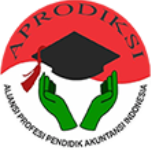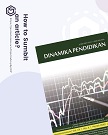Online-Based Simple Cooperative Learning Design (SCL-D) for Accounting
(1) Universitas Negeri Malang
(2) Universitas Negeri Malang
(3) Universitas Negeri Malang
(4) Universitas Negeri Malang
Abstract
This paper aims to provide an alternative design for Simple Cooperative Learning on online learning by accommodating a variety constraints and difficulties faced by teachers and students and answer weaknesses of existing methods. This study used research and development method using ADDIE (Analysis, Design, Development, Implementation, and Evaluation) design to produce an online-based cooperative learning model, namely SCL-D (Simple Cooperative Learning Design). The survey was conducted on a sample of 153 students at state and private vocational schools in Malang city. The results of this research are a learning model. Therefore, this method is suitable for completing research objectives, namely producing an SCL-D learning model that is suitable for learning accounting for vocational high schools with 3M requirements ‘easy, cheap, and attractive’. Online-based learning has many advantages as well as weaknesses. Various e-learning platforms make it easy for teachers and students to interact in online learning. The teacher's ability to design attractive distant learning is a determining factor for the success of the learning process. The test results of the SCL-D model show that through this simple cooperative learning design improves student learning achievement.
Keywords
Full Text:
PDFReferences
Alawamleh, M., Al-Twait, L. M., & Al-Saht, G. R. (2020). The effect of online learning on communication between instructors and students during Covid-19 pandemic. Asian Education and Development Studies. https://doi.org/10.1108/AEDS-06-2020-0131
Alshammari, F., Saguban, R., Pasay-an, E., Altheban, A., & Al-Shammari, L. (2017). Factors affecting the academic performance of student nurses: A cross-sectional study. Journal of Nursing Education and Practice, 8(1), 60 https://doi.org/10.5430/jnep.v8n1p60
Anonim. (2020). Data Covid Terupdate 17 Oktober 2020. http://tribunnews.com (Online). Diakses pada 18 Oktober 2020)
Ballantine, J., & Larres, P. M. C. (2007). Cooperative learning: A pedagogy to improve students’ generic skills? Education and Training, 49(2), 126–137. https://doi.org/10.1108/00400910710739487
Cheung, L. (2016). Using the ADDIE Model of Instructional Design to Teach Chest Radiograph Interpretation. Journal of Biomedical Education, 2016, 1–6. https://doi.org/10.1155/2016/9502572
Crisanto, M. A. L. (2018). Group reporting as a tool to enhance the quality of courses. Asian Association of Open Universities Journal, 13(1), 73–87. https://doi.org/10.1108/aaouj-01-2018-0006
Dahiya, S., Jaggi, S., Chaturvedi, K., Bhardwaj, A., Goyal, R., & Varghese, C. (2016). An eLearning System for Agricultural Education. Indian Research Journal of Extension Education, 12(3).
Gay, L. R., & Mills, G. E. (2012). Educational Research: Competencies for Analysis & Aplications. Tenth Edition. Pearson Education, Inc.
Gazit, T., & Aharony, N. (2018). Factors explaining participation in WhatsApp groups: an exploratory study. Aslib Journal of Information Management, 70(4), 390–413. https://doi.org/10.1108/AJIM-03-2018-0053
Goode, S. R. (2020). Using a Case Study to Teach Hazard Analysis and Risk Minimization. Journal of Chemical Education. https://doi.org/10.1021/acs.jchemed.0c00127
Hebles, M., Yaniz-Álvarez-de-Eulate, C., & Jara, M. (2019). Impact of cooperative learning on teamwork competence. Academia Revista Latinoamericana de Administración. Vol. 32 No. 1, pp. 93-106.
Johnson, D. W., & Johnson, R. T. (2009). Theory Into Practice Making cooperative learning work. Am Soc Microbiol, 38(2), 67–73. https://doi.org/10.1080/00405849909543834
Kusmuriyanto, K., & Astuti, D. (2020). Conservation-Based Teaching Materials of Financial Accounting: A Learning Innovation. Dinamika Pendidikan, 15(2), 190-201. doi: https://doi.org/10.15294/dp.v15i2.27189
Malhotra, D. K., & Bansal, S. (2017). Magnetism of WhatsApp among veterinary students. Electronic Library, 35(6), 1259–1267. https://doi.org/10.1108/EL-04-2016-0086
McClellan, C. (2016). Teamwork, collaboration, and cooperation as a student learning outcome for undergraduates. Assessment Update. https://www.infona.pl/resource/bwmeta1.element.wiley-au-v-28-i-1-au30045
Nandakumar, S. R., Le Gallo, M., Piveteau, C., Joshi, V., Mariani, G., Boybat, I., ... & Eleftheriou, E. (2020). Mixed-precision deep learning based on computational memory. Frontiers in Neuroscience, 14, 406. https://doi.org/10.3389/fnins.2020.00406
Parker, S., Warren, N., & … S. H. (2020). Enhancing the quality of supervision: description and initial outcomes of a blended-learning approach to RANZCP supervisor accreditation. Australasian Psychiatry. https://doi.org/10.1177/1039856220928875
Prasetyo, P., & Anggraeni, O. (2020). The Effectiveness of Digital Literacy in Economic Learning. Dinamika Pendidikan, 15(2), 136-147. doi: https://doi.org/10.15294/dp.v15i2.26474
Rastati, R. (2018). Media Literasi Bagi Digital Natives: Perspektif Generasi Z di Jakarta. Jurnal Teknologi Pendidikan, 6(1), 60. https://doi.org/10.31800/jtp.kw.v6n1.p60--73
Rohmah, F. (2016). Analisis kesiapan sekolah terhadap penerapan pembelajaran online (e-learning) di SMA Negeri 1 Kutowinangun. Jurnal Elektronik Pendidikan Teknik Informatika, 5(4). http://journal.student.uny.ac.id/ojs/ojs/index.php/pti/article/view/4690
Saleh, S. M., Asi, Y. M., & Hamed, K. M. (2013). Effectiveness of integrating case studies in online and face-to-face instruction of pathophysiology: A comparative study. American Journal of Physiology - Advances in Physiology Education, 37(2), 201–206. https://doi.org/10.1152/advan.00169.2012
Salman, M., Mustafa, Z. U., Asif, N., Zaidi, H. A., Hussain, K., Shehzadi, N., Khan, T. M., & Saleem, Z. (2020). Knowledge, attitude and preventive practices related to COVID-19: a cross-sectional study in two Pakistani university populations. Drugs and Therapy Perspectives, 36(7), 319–325. https://doi.org/10.1007/s40267-020-00737-7
Sanjaya, W. (2008). Startegi Pembelajaran Standar Berorientasi Standar Proses. Jakarta: Kencana Predana Media Group.
Shoimin, A. (2016). Model Pembelajaran Inovatif alam Kurikulum 2013. Yogyakarta: Ar-ruzz Media.
Slavin. (2014). Cooperative learning in elementary schools. Taylor & Francis, 43(1), 5–14. https://doi.org/10.1080/03004279.2015.963370
Slavin, R. (2009). Cooperative Learning; Teori, Riset dan Praktik. Bandung: Nusa Media.
Solihatin, E. (2008). Pembelajaran Kooperatif IPS. Jakarta: Pustaka Widya.
Strauß, S., & Rummel, N. (2020). Promoting interaction in online distance education: designing, implementing and supporting collaborative learning. In Information and Learning Science (Vol. 121, Issues 5–6, pp. 251–260). Emerald Group Publishing Ltd. https://doi.org/10.1108/ILS-04-2020-0090
Waller, V., & Wilson, J. (2001). A definition for e-learning. TheODL QC Newsletter.
Wang, B., & Bing, W. (2017). The College English Teaching Reform Based on MOOC. English Language Teaching, 10(2). https://doi.org/10.5539/elt.v10n2p19
West, M. A., & Markiewicz, L. (2008). Building Team-Based Working: A Practical Guide to Organizational Transformation - Michael A. West, Lynn Markiewicz - Google Books. Blackwell Publishing Ltd
Wieser, D., Seeler, J.-M., Sixl-Daniell, K., & Zehrer, A. (2018). Assessing The Study Experience in Online Education and The Relevance of Expectations: Seeing The Successful Implementation of Online Education in A New Light. Conference: Research in Action. University of Iceland, Reykjavík: European Academy of Management.
Willis, R. L., Lynch, D., Fradale, P., & Yeigh, T. (2019). Influences on purposeful implementation of ICT into the classroom: An exploratory study of K-12 teachers. Education and Information Technologies, 24(1), 63–77. https://doi.org/10.1007/s10639-018-9760-0
Zeinolabedini, M., & Gholami, J. (2014). The Effect of the Cooperative Learning Method Advocated by Multiple Intelligence Theory on Iranian EFL Learners’ Writing Achievement. The TFLTA Journal.
Refbacks
- There are currently no refbacks.

This work is licensed under a Creative Commons Attribution 4.0 International License.

.png)

.png)





